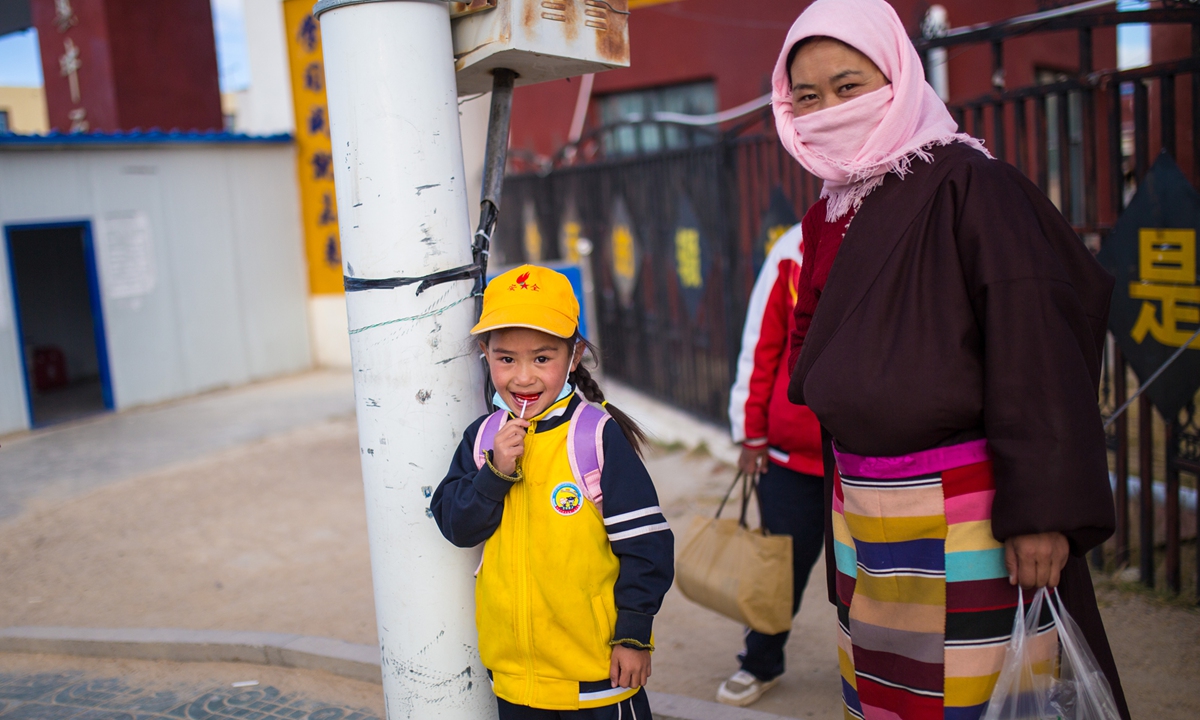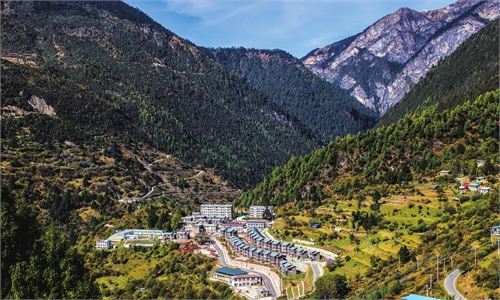
A student and her mother leave school after class in Baingoin county, Nagqu, Southwest China's Xizang Autonomous Region, on October 13, 2023.Photo: Shan Jie/GT
With the correct policies and leadership of the Communist Party of China (CPC), the development of Southwest China's Xizang Autonomous Region is presented with real examples and data, allowing people to see the true development of Xizang, leaving the separatist forces speechless and can only smear the development in the region, on a Tuesday forum, China's top experts of Tibetology said while discussing a recently-published white paper on China's policies in governing Xizang and the achievements it has gained.
On November 21, a high-level forum on the practice of the CPC's strategy for governing Xizang in the new era and its historic achievements was hosted by the China Tibetology Research Center in Beijing. Nearly 50 experts and scholars participated.
The white paper, CPC Policies on the Governance of Xizang in the New Era: Approach and Achievements, was released on November 10 by the State Council Information Office.
Chen Zongrong, deputy director-general of the China Tibetology Research Center, said in his speech that the white paper uses detailed data and a large number of facts to systematically summarize the all-round progress and historic achievements in various undertakings in Xizang under the guidance of the CPC's Xizang governance strategy in the new era. This irrefutably shows that Xizang's economic and social development and progress is a typical epitome of China's glorious achievements in construction and development, and is a miracle of human development created by the Chinese path to modernization on the roof of the world.
"In the face of slanderous attacks on China's Xizang-related policies by some foreign forces and the Dalai Lama clique, the correct way for us to open the window to observe Xizang is to adhere to the correct outlook on development, human rights, progress, and values," Chen noted.
He further noted that the Dalai Lama clique and foreign forces are so passionate that they insist on "representing" the Tibetan people and calling themselves the "masters" of the Tibetan people. They shout that they "sympathize" with the Tibetan people, but this is only the purely "crocodile tears."
The white paper highlights real cases and detailed data to fully demonstrate the victory achieved in the battle against extreme poverty that had plagued Xizang for thousands of years, achievement of moderate prosperity, a more stable social situation, more prosperous economic and cultural development, better ecological environment, and happier lives for the people. Meanwhile, the Party's policy on religious affairs is fully implemented in Xizang, the fight against separatism continues to deepen, the adaptation of Xizangan Buddhism to the socialist society is continuously promoted, and a shared sense of belonging for the Chinese nation has been consolidated in the region, the white paper noted.
According to the white paper, in 2022, Xizang's GDP reached 213.26 billion yuan, an increase by a factor of 2.28 compared with that in 2012 at constant prices, representing an average annual growth rate of 8.6 percent. Its economic growth rate ranked among the highest in China.
"Today in Xizang, the Tibetan language is widely used, Tibetan ancient books and documents are protected and utilized, cultural heritage protection is continuously strengthened, intangible cultural heritage is effectively inherited, and cultural facilities are reachable for people," Su Faxiang, professor and dean of the School of Tibetan Studies at Minzu University of China, pointed out at the forum.
Xiao Jie, deputy director and researcher of the Institute of Contemporary Research at the China Tibetology Research Center, pointed out that judging from the historical process, the successful implementation of the CPC's Xizang governance strategy in the new era is not only conducive to Xizang's long-term stability and high-quality development, but also provides a guarantee for maintaining national security, especially political security, at the strategic level.
Xiao's colleague, Yang Tao, associate researcher at the Institute of Social and Economic Research of the China Tibetology Research Center, stated that judging from the 17 indicators of the United Nations Sustainable Development Goals (SDGs), Xizang has reached the forefront or made great progress in many indicators. In fact, Xizang is becoming one of the model regions in China's implementing of the United Nations 2030 Agenda for Sustainable Development.
Zhang Yongpan, a research fellow of the Institute of Chinese Borderland Studies of the Chinese Academy of Social Sciences, told the Global Times during the forum that in the past few years, Xizang also launched the construction of well-off villages in border areas. At the same time, thanks to the central government's all-out efforts in poverty alleviation, people of all ethnic groups in Xizang's border areas have achieved a very big development.
"It can be said that the publication of the white paper allows the world to re-examine the great changes in Xizang in the past 11 years and tell the world with a firm voice that the China's policies for governing Xizang is completely correct," he said.
He noted that after the white paper was published, the Dalai Lama clique repeated its old tricks and tried to refute it. However, in fact, after seeing the real data, it could not come up with any effective method, so it had to use some slanders to smear the development in Xizang.



